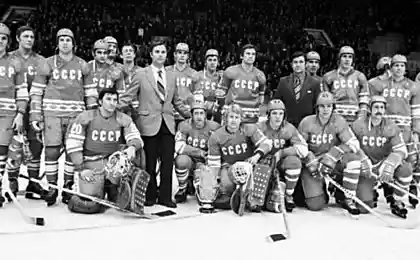2004
Soviet car industry - as a big haystack.
Soviet car industry - as a big haystack. At first glance, only withered grass, but a good digging you can find something valuable and banal needles. "Motor" recalls the most interesting conceptual, experimental and small-scale development of domestic engineers and designers. Today - the first series. NAMI-1 1925god.
It is often called the first car of the USSR, although US-1, received a short lease of life thanks to the small-scale assembly, correctly considered the prototype. This chaise - a prototype of mass passenger cars for the needs of the young Soviet republic. And for the "first pancake" everything was bad. A matter of respect, for example, the process of development. After US-1 has not been licensed or, as often happened, unlicensed copy of a foreign counterpart, and was an example of creative thinking, technical and engineering trends of the era. Hence, by the way, and accusations of copying Tatra 11 (spinal frame) or Lancia Lambda (the overall design of the body).
Another plus US-1 - in the original adaptation for use in the Soviet Union. Note the huge 26-inch ground clearance, curb weight of almost half a ton, provides a good cross on bad roads, and simplicity of design, expressed, for example, in the absence of the differential, engine air cooling and complete renunciation of control devices (in the first version of the model) . With good basic qualities of NAMI-1 did not have a gloss of engineering refinement. This circumstance, as well as the complexity of the preparation of mass production, stood in the way of interesting machines. Motorization of the USSR decided to start cooperation with overseas concern Ford, and US-1, after a few hundred copies issued by semi-artisan way, has shifted from the roads and streets in museums and storerooms.
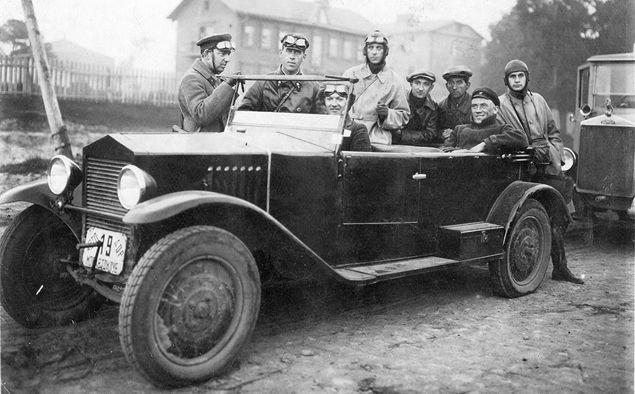
GAZ "A-Aero" in 1932.
In these times, this project would be called a thesis than a concept car. But just look at these forms and correlate them with the year of issue! In the early 30's aerodynamics in automotive engineering just got up from his knees and made the first tentative steps. And so nice that this forward movement is and the contribution of domestic talent.
In fact, the "A-Aero" Moscow engineer Alexei Nikitin was a refined aerodynamic body, worn on the chassis of GAZ-A standard. The car turned out not simply an unusual and attractive. All major prettiness "Aero", like the integrated headlamps enclosed rear arches and extended keel, worked to reduce drag. And it works not only in theory but also in practice. During the test, "Aero" concept car, to put it mildly, surprised the others by a quarter to reduce fuel consumption and maximum speed, which has grown by almost 30 kilometers per hour compared to the base "jeep." I wish to continue this wonderful story did not get wind. The very same "A-Aero" vanished without a trace.
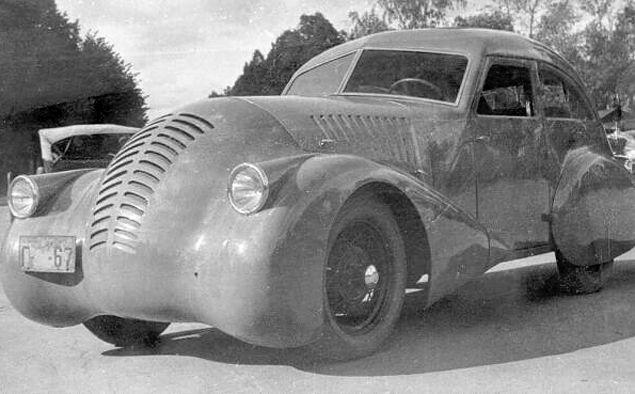
US-013 1950 god.
This was a concept car with no discount or apology. His inspirer - Yuri Dolmatovsky, brother of the Soviet poet Yevgeny Dolmatovski. Not only an engineer, but also a designer, journalist and one of the most prominent popularizers of the car in the USSR, Yuri Aronovich in the late '40s began to think about the pros wagon-type. It was during his participation and began to develop the first Soviet passenger monocab.
Concept Car NAMI-013, as it is today like to say ahead of his time. Indeed! Rear-engined layout, five meters in length, three rows of seats and the driver, sitting in front of the front axle - this is, anyway, a breakthrough. Alas, enthusiasm Dolmatovski received favorable even in the pages of the foreign automotive press, found no support in the higher courts. Then only the prototype did not get, and he disposed of in 1954.
And after seven years in the United States debuted rear-drive, rear-monocab Chevrolet Corvair Greenbrier, ideologically very similar to the car Dolmatovski.

ZIS-112 1951 god.
Again on a clean concept car - both product engineering designed to rotate the gears of technological progress, this beauty is not drawn. Before us is "just" a racing car chassis ZIS-110. But even on the very specific linear races - races in pairs several hundred kilometers in length, which were held on conventional highway, the 112th was not demonstrated outstanding results. But the role of Dream car - cars, if not asserting the superiority of socialist industry on the "decadent West", at least parity of the sides, the car is ideal.
The brainchild of Valentina sprout easy to blame imitation conceptual Buick Le Sabre. But the two cars appeared almost simultaneously and both are beautiful in their own way. But in the 112-meters was a true Russian scale: nearly six meters long, fearsome cyclopean spotlight in the center, rollicking "whiskers" growing out of the front fairing, and calling on the strong side of the front wings. It was cool! And not only in design. The version of the pump over a row (!) Eight-cylinder engine Dream car developed almost 200 horsepower and, according to his contemporaries, peremahival over two hundred of the maximum speed.

"Squirrel" in 1955.
Having failed to NAMI-013, Yuri Dolmatovsky not disappointed in the carriage arrangement. And when the management of IMZ-Ural to think about the issue at its facilities car, guide us once again the idea was to spin a compact monocab.
Now he really was very compact - a length of less than 3, 5 meters and a curb weight - about half a ton. This mikrovenchik named "Squirrel", had a full-fledged five-seater saloon, and its 700-cc motorcycle engine gave out a total of 20 horsepower. However, given the low weight, it is enough to travel around the city. Among other things, "Squirrel" was elegant and in a good futuristic - which is only the front part of the cab to access the room, leans forward. However, good thought with a view to mass production design concept remained. Building cars in Irbit changed their minds, and a second chance "Squirrel" was not given.
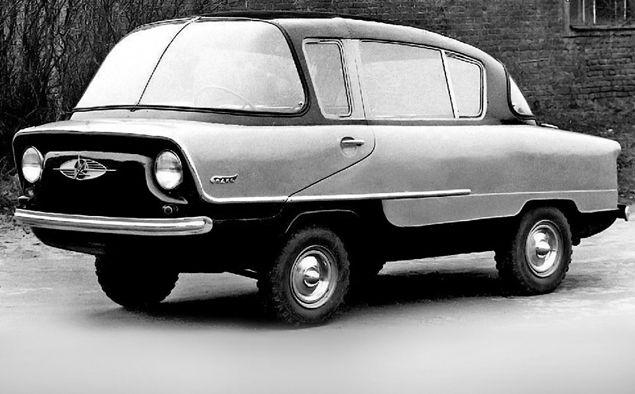
MZMA "Moskvich-444" in 1958.
The fact that the first "Zaporozhets", nicknamed by the people "humpbacked" - is a clone of Italian minicar FIAT, they know almost everything. But not many people know that in the beginning of his career "Constipation", in fact, was the "Moskvich».
According to the original plan, "humpback" had to get up on the conveyor of the Moscow plant of small cars (MZMA), later better known as AZLK. It is for this purpose in Europe have bought a few copies of the popular FIAT 600 - they dismantled, look inside and say, creatively reworked. Despite the change the diameter of wheels and cosmetic changes in the external design, it was clear from his ears stick out of the "national development».
Eventually, borrowed design MZMA not bring happiness. By order of the top ready-concept urban project "Moskvich" with all the technical documentation and driving prototypes passed Ukrainian factory "Kommunar" - commonly known parent "Constipation." A "Moskvich" and remained a prototype.
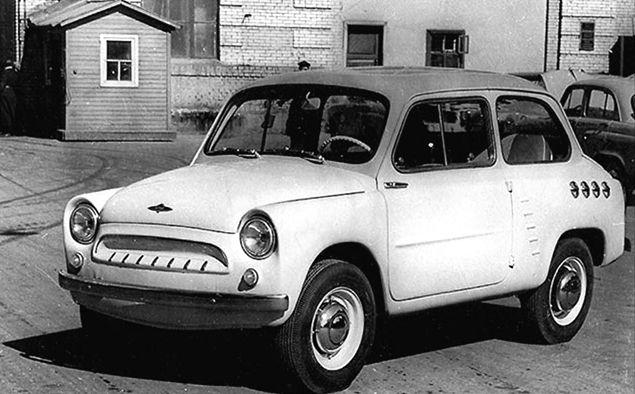
"Youth" ZIL-118 1960 god.
One of the most beautiful cars ever created in the Soviet Union - the bus "Youth" - you can call and grimace of the socialist economy. Suffice it to say that this bus was created on the nodes and units of government limousine ZIL-111. Just imagine a taxi or ambulance weighing four tons and even a voracious gasoline V8 under the hood. Absurd!
But the appearance of "Youth" would have done credit to the best European and body studio at the time. Futuristic and fresh exterior minibus in the Soviet realities seemed almost a revelation. Even beauty "Volga" GAZ-21 - the most fashionable at the time of the USSR the car - next to the ZIL-118 looked down to earth and modest.
Not in the beauty, truth, happiness. Despite his article "Youth" was unplanned, semi-official and, therefore, not the favorite child of ZIL. Created almost on a voluntary basis, the bus went to an expensive production overhead in operation (fuel consumption exceeds 25 liters per 100 kilometers), and most importantly, its scope was too specific. For a complete bus or coach, he did not pull, and for the minibus was too bulky and heavy. In short, despite the success in the "Bus Week in Nice" in 1967, where the car has received the Grand Prix, "Youth" and remains a beautiful and largely progressive design, which ultimately were not wanted.
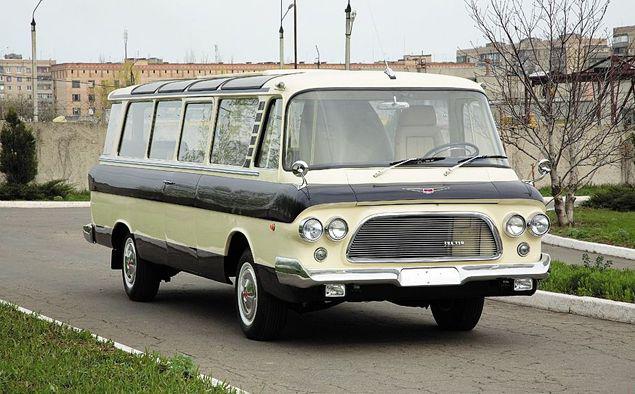
VNIITE PT 1963.
You'll laugh, but after the second "breakup" with the monocab Yuri Dolmatovsky did not give up. Talented and hard designer decided to step on a rake of socialist realism for the third time. Again, it all started as a good idea.
Absolutely sound idea adaptation of "monospeysa" to the needs of taxi Yuri Aronovich infected experts VNIITE (All-Union Scientific Research Institute of Technical Aesthetics). Taking the experience of operating a taxi on the basis of the usual "Volga" GAZ-21 and methodically removing all of its inherent flaws, presented a draft Dolmatovsky Perspective Taxi.
Needless to say, it was monocab? The driver sat in front of the front axle, while the engine was close to the drive wheels, that is behind. In addition, PT VNIIETO was also a body of fiberglass, the prospects for which at the time seemed endless. Equally revolutionary looked sliding door on the right and a huge amount of time by the standards of the cabin, where passengers could sit with his legs crossed. The advantages of the machine we put as excellent visibility and ease of operation of an active - for example, very important for the taxi easy cleaning of the body and interior cleaning. Finally, the 50-strong "Moskvitch" motor provides quite adequate for a city taxi 100 kilometers per hour maximum speed. Alas, as in previous cases, the work Dolmatovski praised, and only.
But today, looking at the special Nissan NV200 Taxi, traveling about the streets of New York and London, it's hard not to notice a whole heap of similarities "Japanese" from the perspective of Taxi VNIITE.

"Moskvich-408 Tourist" in 1964.
From the tens and hundreds of factory prototypes that were not included in our selection, the experimental convertible features one fundamental thing. The order for its production came from abroad. According to the official version, "Moskvich-408" with a removable hardtop developed at the request of the European importer of Soviet cars Scaldia Volga. This machine company from Belgium hoped to rouse interest to start the export of conventional 408-x.
Cabrio of the sedan made in the simplest way - cutting off all unnecessary. Fortunately, "obeskryshivaniem" test did not stop. Was reinforced body, removed the extra rear doors and front stripped frames. Moreover, one of the two prototypes was built aluminum body panels and even the engine with fuel injection system. But the main thing, of course, design. "Moskvich-408" and had a reputation for itself an impressive vehicle, and "Tourist" - is generally pure sex. One of the most elegant cars of the USSR, alas, is not privileged to mass production.

VAZ-1972 E1101.
With pipeline Togliatti giant still has not sunk first "penny" and VAZ designers already thought ahead. At the end of the 60s it became clear - Automotive Europe confident change to front-wheel drive. In this sense, the FIAT-124 classic layout selected as a prototype of the VAZ-2101, was among the laggards. That is why promising minicar vazovtsy seen not only perednemotornoy, but front-wheel!
Compact "VAZ-E1101 ', not otherwise than for the compassionate gaze piercing headlights nicknamed" Cheburashka ", created exclusively by internal forces VAZ and without the participation of foreign experts. Although, judging by the designs, the designers were inspired by the style of Austin Mini, Autobianchi A112, Honda N600. But more importantly - almost everything vazovtsam had to create from scratch. Not only the body but also the motor (0, 9 liters with return of 50 horsepower) and a transmission (a four). Project fluttering long. "Cheburashka" not only lived up to the stage driving a prototype, but even before the updated body. Restyling for the concept car - it was in the spirit of Soviet long-term construction. However, the assembly line, it never came.
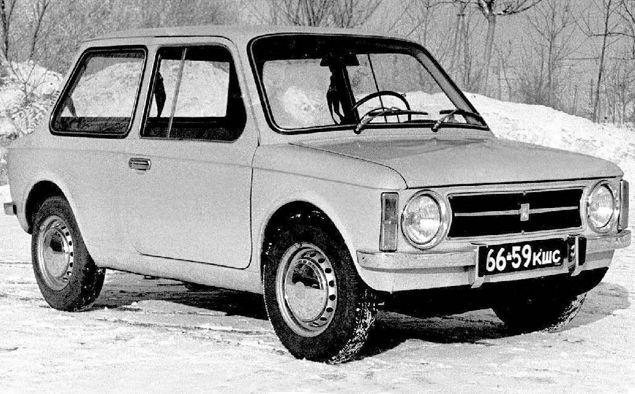
VAZ 1801 "Pony" in 1979.
The original decision unoriginal ideas. Easy open avtomobilchik - want to call it buggy want - golf cart designed for the Olympics-80, I stood and good looks, and non-trivial engineering solutions. Suffice it to say that the "Pony" was electric cars! Nickel-zinc batteries, weighing 180 kilograms each, at the VAZ-1801 had two. One was located in the front section, the other - in the rear. Cruising was 110-120 kilometers when driving at a speed of 40 kilometers per hour. But in the end the Soviet auto habitual frequenter was only interesting project.

"Ohta" US in 1987.
Create a master Samodelkina Hainovym Gennady and Dmitry Parfenov, "Ohta" is not just a luxury aerodynamic body, and a flat floor in the cabin, an active spoiler, and most importantly - the wiring on the shared bus for data exchange. For the end of the 80 multiplex - fantastic in the square! However, Safety-nothing more unique was not - then aggregates used by VAZ "Eight».

MAZ-2000 "Perestroika" in 1988.
One of the few Soviet concept truck. And probably the only media really good concept. Catchy design "Perestroika" - is one thing, but the original modular layout train with composing, depending on the required load capacity motorized carriages, is another. On the verge of 90, it seemed the solution of the future. Time has shown that the "Perestroika", as well as its modular trolley - it is a comfortable distance.
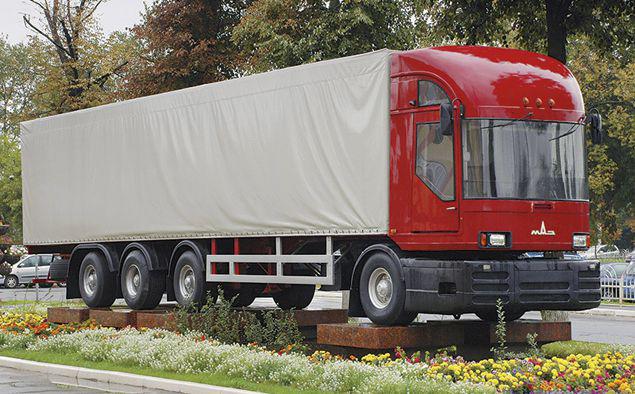
NAMI-0288 CD 1988.
Small-car project, which is the modern classification can be attributed to the Class B, surprised exaggerated attention to aerodynamics, interesting layout decisions, okay for the end of the 80s design. But the main achievement of the machine remains part in the Tokyo Motor Show, where the concept has received the award. Foreign comrades looked at the "Compact" with interest and surprise - from the Soviet Union did not expect such progress.

"Orange" NAMI-0290 1988 god.
Rally "Party B» in the Soviet or just "Orange" - a racing car, the engineers created us free time. The spatial tubular frame, forced 1, 5-liter engine from the "Six", plus body panels, stylized mix of Peugeot 205 T16, Lancia Delta S4 and Ford RS200 - that's the recipe of one of the most exciting sports cars of the Soviet 80s. Unfortunately, in the 90's "Orange" was cut into pieces and thrown in a landfill, as well as many other unique machine of the Soviet Union.

Source: motor.ru
It is often called the first car of the USSR, although US-1, received a short lease of life thanks to the small-scale assembly, correctly considered the prototype. This chaise - a prototype of mass passenger cars for the needs of the young Soviet republic. And for the "first pancake" everything was bad. A matter of respect, for example, the process of development. After US-1 has not been licensed or, as often happened, unlicensed copy of a foreign counterpart, and was an example of creative thinking, technical and engineering trends of the era. Hence, by the way, and accusations of copying Tatra 11 (spinal frame) or Lancia Lambda (the overall design of the body).
Another plus US-1 - in the original adaptation for use in the Soviet Union. Note the huge 26-inch ground clearance, curb weight of almost half a ton, provides a good cross on bad roads, and simplicity of design, expressed, for example, in the absence of the differential, engine air cooling and complete renunciation of control devices (in the first version of the model) . With good basic qualities of NAMI-1 did not have a gloss of engineering refinement. This circumstance, as well as the complexity of the preparation of mass production, stood in the way of interesting machines. Motorization of the USSR decided to start cooperation with overseas concern Ford, and US-1, after a few hundred copies issued by semi-artisan way, has shifted from the roads and streets in museums and storerooms.

GAZ "A-Aero" in 1932.
In these times, this project would be called a thesis than a concept car. But just look at these forms and correlate them with the year of issue! In the early 30's aerodynamics in automotive engineering just got up from his knees and made the first tentative steps. And so nice that this forward movement is and the contribution of domestic talent.
In fact, the "A-Aero" Moscow engineer Alexei Nikitin was a refined aerodynamic body, worn on the chassis of GAZ-A standard. The car turned out not simply an unusual and attractive. All major prettiness "Aero", like the integrated headlamps enclosed rear arches and extended keel, worked to reduce drag. And it works not only in theory but also in practice. During the test, "Aero" concept car, to put it mildly, surprised the others by a quarter to reduce fuel consumption and maximum speed, which has grown by almost 30 kilometers per hour compared to the base "jeep." I wish to continue this wonderful story did not get wind. The very same "A-Aero" vanished without a trace.

US-013 1950 god.
This was a concept car with no discount or apology. His inspirer - Yuri Dolmatovsky, brother of the Soviet poet Yevgeny Dolmatovski. Not only an engineer, but also a designer, journalist and one of the most prominent popularizers of the car in the USSR, Yuri Aronovich in the late '40s began to think about the pros wagon-type. It was during his participation and began to develop the first Soviet passenger monocab.
Concept Car NAMI-013, as it is today like to say ahead of his time. Indeed! Rear-engined layout, five meters in length, three rows of seats and the driver, sitting in front of the front axle - this is, anyway, a breakthrough. Alas, enthusiasm Dolmatovski received favorable even in the pages of the foreign automotive press, found no support in the higher courts. Then only the prototype did not get, and he disposed of in 1954.
And after seven years in the United States debuted rear-drive, rear-monocab Chevrolet Corvair Greenbrier, ideologically very similar to the car Dolmatovski.

ZIS-112 1951 god.
Again on a clean concept car - both product engineering designed to rotate the gears of technological progress, this beauty is not drawn. Before us is "just" a racing car chassis ZIS-110. But even on the very specific linear races - races in pairs several hundred kilometers in length, which were held on conventional highway, the 112th was not demonstrated outstanding results. But the role of Dream car - cars, if not asserting the superiority of socialist industry on the "decadent West", at least parity of the sides, the car is ideal.
The brainchild of Valentina sprout easy to blame imitation conceptual Buick Le Sabre. But the two cars appeared almost simultaneously and both are beautiful in their own way. But in the 112-meters was a true Russian scale: nearly six meters long, fearsome cyclopean spotlight in the center, rollicking "whiskers" growing out of the front fairing, and calling on the strong side of the front wings. It was cool! And not only in design. The version of the pump over a row (!) Eight-cylinder engine Dream car developed almost 200 horsepower and, according to his contemporaries, peremahival over two hundred of the maximum speed.

"Squirrel" in 1955.
Having failed to NAMI-013, Yuri Dolmatovsky not disappointed in the carriage arrangement. And when the management of IMZ-Ural to think about the issue at its facilities car, guide us once again the idea was to spin a compact monocab.
Now he really was very compact - a length of less than 3, 5 meters and a curb weight - about half a ton. This mikrovenchik named "Squirrel", had a full-fledged five-seater saloon, and its 700-cc motorcycle engine gave out a total of 20 horsepower. However, given the low weight, it is enough to travel around the city. Among other things, "Squirrel" was elegant and in a good futuristic - which is only the front part of the cab to access the room, leans forward. However, good thought with a view to mass production design concept remained. Building cars in Irbit changed their minds, and a second chance "Squirrel" was not given.

MZMA "Moskvich-444" in 1958.
The fact that the first "Zaporozhets", nicknamed by the people "humpbacked" - is a clone of Italian minicar FIAT, they know almost everything. But not many people know that in the beginning of his career "Constipation", in fact, was the "Moskvich».
According to the original plan, "humpback" had to get up on the conveyor of the Moscow plant of small cars (MZMA), later better known as AZLK. It is for this purpose in Europe have bought a few copies of the popular FIAT 600 - they dismantled, look inside and say, creatively reworked. Despite the change the diameter of wheels and cosmetic changes in the external design, it was clear from his ears stick out of the "national development».
Eventually, borrowed design MZMA not bring happiness. By order of the top ready-concept urban project "Moskvich" with all the technical documentation and driving prototypes passed Ukrainian factory "Kommunar" - commonly known parent "Constipation." A "Moskvich" and remained a prototype.

"Youth" ZIL-118 1960 god.
One of the most beautiful cars ever created in the Soviet Union - the bus "Youth" - you can call and grimace of the socialist economy. Suffice it to say that this bus was created on the nodes and units of government limousine ZIL-111. Just imagine a taxi or ambulance weighing four tons and even a voracious gasoline V8 under the hood. Absurd!
But the appearance of "Youth" would have done credit to the best European and body studio at the time. Futuristic and fresh exterior minibus in the Soviet realities seemed almost a revelation. Even beauty "Volga" GAZ-21 - the most fashionable at the time of the USSR the car - next to the ZIL-118 looked down to earth and modest.
Not in the beauty, truth, happiness. Despite his article "Youth" was unplanned, semi-official and, therefore, not the favorite child of ZIL. Created almost on a voluntary basis, the bus went to an expensive production overhead in operation (fuel consumption exceeds 25 liters per 100 kilometers), and most importantly, its scope was too specific. For a complete bus or coach, he did not pull, and for the minibus was too bulky and heavy. In short, despite the success in the "Bus Week in Nice" in 1967, where the car has received the Grand Prix, "Youth" and remains a beautiful and largely progressive design, which ultimately were not wanted.

VNIITE PT 1963.
You'll laugh, but after the second "breakup" with the monocab Yuri Dolmatovsky did not give up. Talented and hard designer decided to step on a rake of socialist realism for the third time. Again, it all started as a good idea.
Absolutely sound idea adaptation of "monospeysa" to the needs of taxi Yuri Aronovich infected experts VNIITE (All-Union Scientific Research Institute of Technical Aesthetics). Taking the experience of operating a taxi on the basis of the usual "Volga" GAZ-21 and methodically removing all of its inherent flaws, presented a draft Dolmatovsky Perspective Taxi.
Needless to say, it was monocab? The driver sat in front of the front axle, while the engine was close to the drive wheels, that is behind. In addition, PT VNIIETO was also a body of fiberglass, the prospects for which at the time seemed endless. Equally revolutionary looked sliding door on the right and a huge amount of time by the standards of the cabin, where passengers could sit with his legs crossed. The advantages of the machine we put as excellent visibility and ease of operation of an active - for example, very important for the taxi easy cleaning of the body and interior cleaning. Finally, the 50-strong "Moskvitch" motor provides quite adequate for a city taxi 100 kilometers per hour maximum speed. Alas, as in previous cases, the work Dolmatovski praised, and only.
But today, looking at the special Nissan NV200 Taxi, traveling about the streets of New York and London, it's hard not to notice a whole heap of similarities "Japanese" from the perspective of Taxi VNIITE.

"Moskvich-408 Tourist" in 1964.
From the tens and hundreds of factory prototypes that were not included in our selection, the experimental convertible features one fundamental thing. The order for its production came from abroad. According to the official version, "Moskvich-408" with a removable hardtop developed at the request of the European importer of Soviet cars Scaldia Volga. This machine company from Belgium hoped to rouse interest to start the export of conventional 408-x.
Cabrio of the sedan made in the simplest way - cutting off all unnecessary. Fortunately, "obeskryshivaniem" test did not stop. Was reinforced body, removed the extra rear doors and front stripped frames. Moreover, one of the two prototypes was built aluminum body panels and even the engine with fuel injection system. But the main thing, of course, design. "Moskvich-408" and had a reputation for itself an impressive vehicle, and "Tourist" - is generally pure sex. One of the most elegant cars of the USSR, alas, is not privileged to mass production.

VAZ-1972 E1101.
With pipeline Togliatti giant still has not sunk first "penny" and VAZ designers already thought ahead. At the end of the 60s it became clear - Automotive Europe confident change to front-wheel drive. In this sense, the FIAT-124 classic layout selected as a prototype of the VAZ-2101, was among the laggards. That is why promising minicar vazovtsy seen not only perednemotornoy, but front-wheel!
Compact "VAZ-E1101 ', not otherwise than for the compassionate gaze piercing headlights nicknamed" Cheburashka ", created exclusively by internal forces VAZ and without the participation of foreign experts. Although, judging by the designs, the designers were inspired by the style of Austin Mini, Autobianchi A112, Honda N600. But more importantly - almost everything vazovtsam had to create from scratch. Not only the body but also the motor (0, 9 liters with return of 50 horsepower) and a transmission (a four). Project fluttering long. "Cheburashka" not only lived up to the stage driving a prototype, but even before the updated body. Restyling for the concept car - it was in the spirit of Soviet long-term construction. However, the assembly line, it never came.

VAZ 1801 "Pony" in 1979.
The original decision unoriginal ideas. Easy open avtomobilchik - want to call it buggy want - golf cart designed for the Olympics-80, I stood and good looks, and non-trivial engineering solutions. Suffice it to say that the "Pony" was electric cars! Nickel-zinc batteries, weighing 180 kilograms each, at the VAZ-1801 had two. One was located in the front section, the other - in the rear. Cruising was 110-120 kilometers when driving at a speed of 40 kilometers per hour. But in the end the Soviet auto habitual frequenter was only interesting project.

"Ohta" US in 1987.
Create a master Samodelkina Hainovym Gennady and Dmitry Parfenov, "Ohta" is not just a luxury aerodynamic body, and a flat floor in the cabin, an active spoiler, and most importantly - the wiring on the shared bus for data exchange. For the end of the 80 multiplex - fantastic in the square! However, Safety-nothing more unique was not - then aggregates used by VAZ "Eight».

MAZ-2000 "Perestroika" in 1988.
One of the few Soviet concept truck. And probably the only media really good concept. Catchy design "Perestroika" - is one thing, but the original modular layout train with composing, depending on the required load capacity motorized carriages, is another. On the verge of 90, it seemed the solution of the future. Time has shown that the "Perestroika", as well as its modular trolley - it is a comfortable distance.

NAMI-0288 CD 1988.
Small-car project, which is the modern classification can be attributed to the Class B, surprised exaggerated attention to aerodynamics, interesting layout decisions, okay for the end of the 80s design. But the main achievement of the machine remains part in the Tokyo Motor Show, where the concept has received the award. Foreign comrades looked at the "Compact" with interest and surprise - from the Soviet Union did not expect such progress.

"Orange" NAMI-0290 1988 god.
Rally "Party B» in the Soviet or just "Orange" - a racing car, the engineers created us free time. The spatial tubular frame, forced 1, 5-liter engine from the "Six", plus body panels, stylized mix of Peugeot 205 T16, Lancia Delta S4 and Ford RS200 - that's the recipe of one of the most exciting sports cars of the Soviet 80s. Unfortunately, in the 90's "Orange" was cut into pieces and thrown in a landfill, as well as many other unique machine of the Soviet Union.

Source: motor.ru























